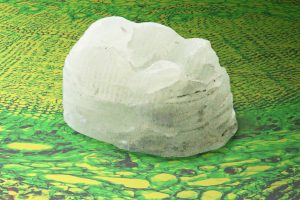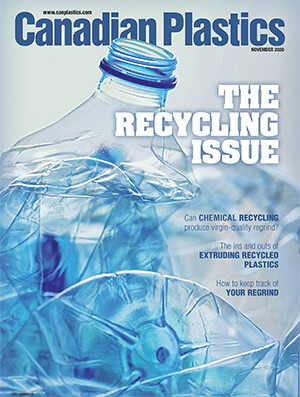
New plant-derived composite with bone-hard toughness
Canadian Plastics
Materials Research & DevelopmentDeveloped by researchers at MIT, the material could pave the way for sustainable plastics.

A tooth made from the new composite printed by the MIT team. Image Credit: Figure courtesy of the researchers, edited by MIT News.
A new woody composite, developed by a research team at Massachusetts Institute of Technology (MIT) in Cambridge, Mass., is as tough as bone and as hard as aluminum, and it could pave way for naturally-derived plastics.
The MIT team has engineered a composite made mostly from cellulose nanocrystals (CNCs) mixed with a bit of synthetic polymer. The organic crystals take up about 60 to 90 per cent of the material, which is the highest fraction of CNCs achieved in a composite to date.
The team hit on a recipe for the CNC-based composite that they could fabricate using both 3D printing and conventional casting. They printed and cast the composite into penny-sized pieces of film that they used to test the material’s strength and hardness. They also machined the composite into the shape of a tooth to show that the material might could be used to make cellulose-based dental implants – or any plastic products – that are stronger, tougher, and more sustainable.
“By creating composites with CNCs at high loading, we can give polymer-based materials mechanical properties they never had before,” said team member A. John Hart. “If we can replace some petroleum-based plastic with naturally-derived cellulose, that’s arguably better for the planet as well.”
Hart and his colleagues looked to develop a composite with a high fraction of CNCs that they could shape into strong, durable forms. They started by mixing a solution of synthetic polymer with commercially available CNC powder. The team determined the ratio of CNC and polymer that would turn the solution into a gel, with a consistency that could either be fed through the nozzle of a 3D printer or poured into a mold to be cast. They used an ultrasonic probe to break up any clumps of cellulose in the gel, making it more likely for the dispersed cellulose to form strong bonds with polymer molecules. They then fed some of the gel through a 3D printer and poured the rest into a mold to be cast, and then let the printed samples dry. In the process, the material shrank, leaving behind a solid composite composed mainly of cellulose nanocrystals.
When the team examined the composite’s structure under a microscope, they also found that grains of cellulose had settled into a brick-and-mortar pattern, similar to the architecture of nacre, also known as mother of pearl. In nacre, this zig-zagging microstructure stops a crack from running straight through the material, and the researchers found the same is true with their new cellulose composite. They tested the material’s resistance to cracks, using tools to initiate first nano- and then micro-scale cracks, and discovered that the composite’s arrangement of cellulose grains prevented the cracks from splitting the material – a resistance to plastic deformation that gives the composite a hardness and stiffness at the boundary between conventional plastics and metals.
Going forward, the team is looking for ways to minimize the shrinkage of gels as they dry; while shrinkage isn’t much of a problem when printing small objects, anything bigger could buckle or crack as the composite dries. “If you could avoid shrinkage, you could keep scaling up, maybe to the meter scale,” Hart said. “Then if we were to dream big, we could replace a significant fraction of plastics with cellulose composites.”
